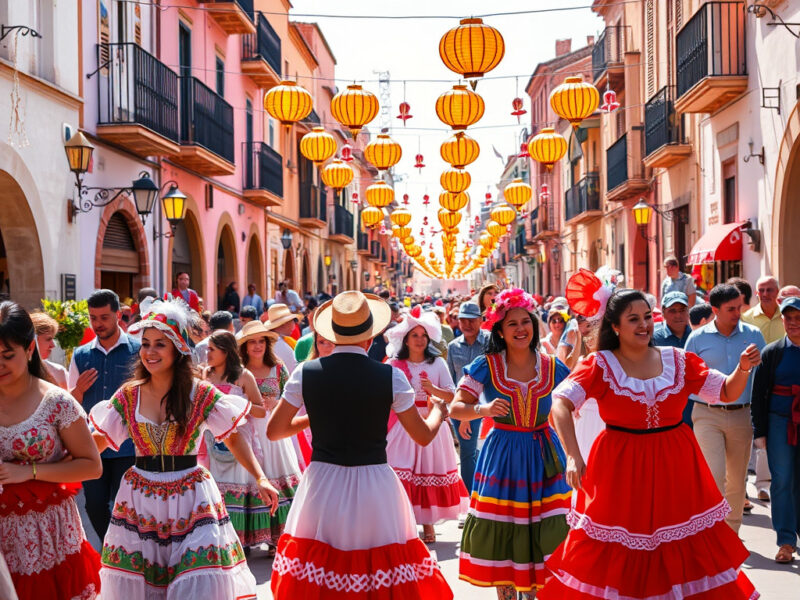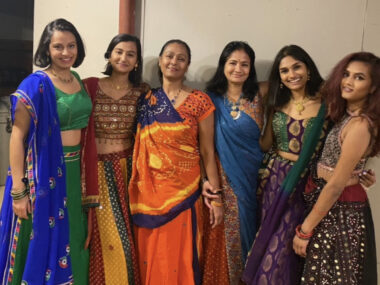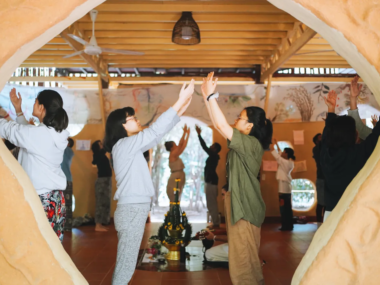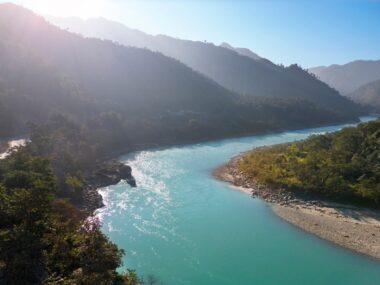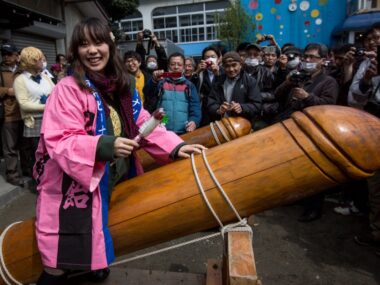Table of Contents
If there is one country that knows how to hold festivals, it’s Spain. The Spanish live for their fiestas – the celebrations that take place at different times throughout the year in every village, town and city across the country. We’re not talking orderly street parties and safety barriers separating the audience from the spectacle. Fiestas are about letting go and embracing the chaos that spills out in every direction.
Forget rules and social niceties: fiestas are not something you watch, they’re something you get fully involved. They’re about hurling yourself into the scrum, getting caked in whatever is being thrown around, partying til dawn, and waking up a little bruised, with ringing ears .. and an unshakeable desire to do it all again.
Fiestas take place throughout the year and each town and village has its own special way of celebrating. These are some of the craziest fiestas you’ll find.
Where Fear IS the Center of Spanish Festivals: The Running of the Bulls
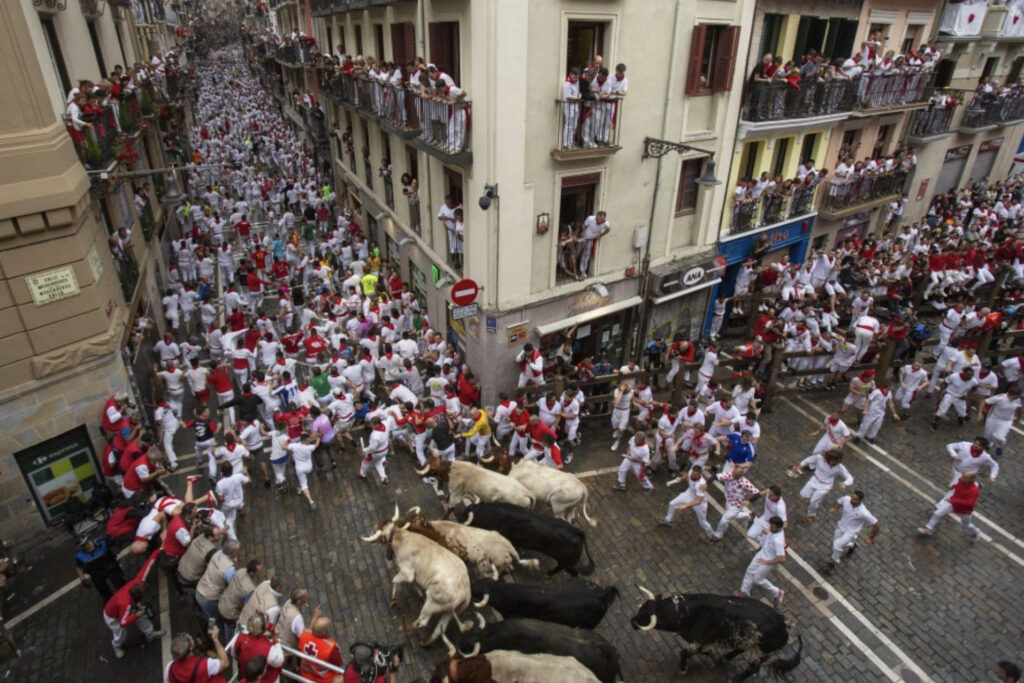
It’s early morning in Pamplona and the streets are already filling up with locals dressed in the traditional white pants and T-shirts, adorned with bright red bandanas. The anticipation is palpable. Then, a rocket cracks the sky and, seconds later, you hear the sound of thundering hooves.
The bulls are coming. Spectators are shouting. People are running. A few leap over barriers to safety, but an unlucky few trip, fall, and curl up into a ball, hoping not to be trampled or gored.
Yes, it’s exactly as mad as it sounds: every morning of the fiesta, six bulls are released among a crowd of thousands who try to outrun them along the city’s narrow and winding cobbled streets. It’s a classic display of Spanish machismo.
But the San Fermines are not just about the chase. While there is a religious component once the danger has passed it’s non-stop fun: concerts, folk music, food stalls, marching bands, fireworks and hearty singalongs. Everyone – men, women and children – packs into the town squares in high spirits. You’ll see toddlers, grandparents, teenagers and tourists all dancing, drinking, and eating in the streets.
The air literally crackles with the energy of thousands of people all determined to party like there’s no tomorrow – except there is, because this particular party goes on for nine days. It doesn’t matter if you’re a visitor or a lifelong resident – everyone is welcome to join in and, because the revelry continues day and night, there’s no FOMO. You can retreat and rest in the and emerge in the early hours and the party will still be in full swing.
The air literally crackles with the energy of thousands of people all determined to party like there’s no tomorrow… Feeling inspired to join the fun? Enter our Uncharted Community
for your chance to win exciting things from our giveaway and learn about Spain’s wildest fiestas from dancing horses to flying tomatoes. Expect the good stuff in your inbox. No spam.
When Horses Dance and Crowds Road: Fiestas de Sant Joan

Menorca, the smallest of the Balearic Islands, is a sleepy place for most of the year. But for a few days in late June, tens of thousands of young people from around the country descend on the island for the Festas de Sant Joan.
Like most fiestas, there are sporting events, cultural celebrations, fair rides, concerts and street parties – but at this particular fiesta, the celebrations peak at an event that is unique to the island: the Jaleo. Translating as ‘chaos’ nobody is pretending that this is an orderly event.
The local fiesta tipple is a potent concoction of the local gin mixed with lemonade that is sold, or given away, all over town. It’s not uncommon to go into a bank or business and find bottles of gin and lemonade laid out for patrons to mix their own.
By the time the music beings and the mayor makes his entrance on the back of a donkey, the excitement swells among the well lubricated crowd. But it’s what comes next that everyone is here for: the horses.
As the brass band strikes up the traditional jaleo tune over 100 beautifully groomed black stallions, their riders in traditional costume, enter the fray two by two. Amidst a crowd so tightly packed you can barely move, the pairs of horses perform a series of intricate steps, in time to the music, before rearing up on their hind quarters. The longer they remain on two legs the louder the crowd cheers. The best are the ones that can take a few steps on their hind legs – and that’s when the revellers really roar, arms stretching out to touch their hearts.
I usually find horses to be nervy creatures, so the combination of thousands of drunk, rowdy people, extremely loud music and huge four-legged beasts all crammed into a small space sounds like a recipe for disaster, or at least for being flattened under 2000 lbs of horse. But these horses are highly trained and somehow stay incredibly calm.
Getting into the centre of the crowd, within touching distance of the horses, is both terrifying and exhilarating: you have to surrender to the ebb and flow of the throng, as there’s no room to move where you want. But the sense of unity, of being in it together, is intoxicating.
If you go to a jaleo be warned: the jaleo tune, which is played over and over, and over, will be stuck in your head for days.
A Fiesta of Fire and Destruction in Valencia: Las Fallas
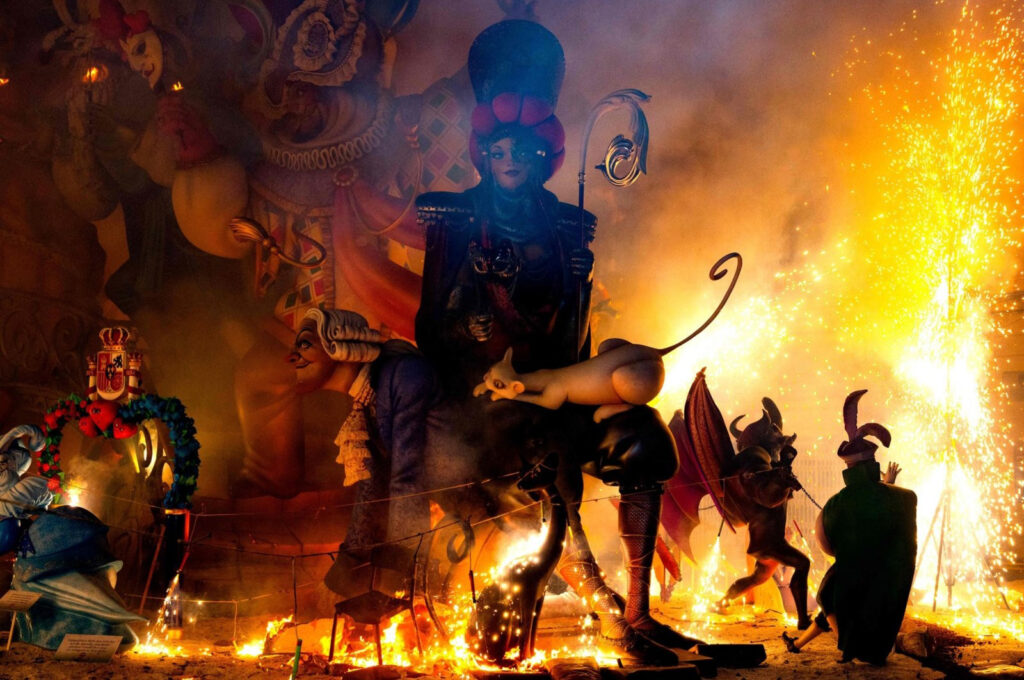
If you’ve ever wanted to see artistic masterpieces deliberately burnt, Valencia in March is the place to be. Las Fallas is a pyromaniac’s dream.
Artists from across the region spend much of the year building massive, incredibly elaborate, beautifully decorated papier-mâché figures – satirical renditions of politicians, cartoon monsters, fantastical beasts – some over 60 feet high. For weeks they are displayed across the city for everyone to admire, and then, on the final day, they are set alight and burned to the ground.
But this is only the fiery finale to an insanely noisy, messy few weeks. Every day in the run up to this, thousands pack into the city’s main square for the ear-splitting ‘mascleta’.
It takes place in the middle of day and is essentially a massive detonation of densely packed firecrackers. But that sounds tame. This is not. It is so loud that the ground shakes, the vibrations rip through your body and leave your ears ringing for hours afterwards. You wonder if you’ll ever hear property again, but bizarrely, the Spanish absolutely love it.
By the last night, it’s complete sensory overload. The city is ablaze with bonfires and burning effigies, fireworks are exploding overhead, kids are running around throwing firecrackers, people are dancing, clapping, and sometimes crying, and the air is thick with the smell of gunpowder.
To an outsider it looks apocalyptic. And yet the crowds cheer, the music plays on, and for Valencians, the destruction is cause for celebration.
The World’s Greatest Food Fight: La Tomatina
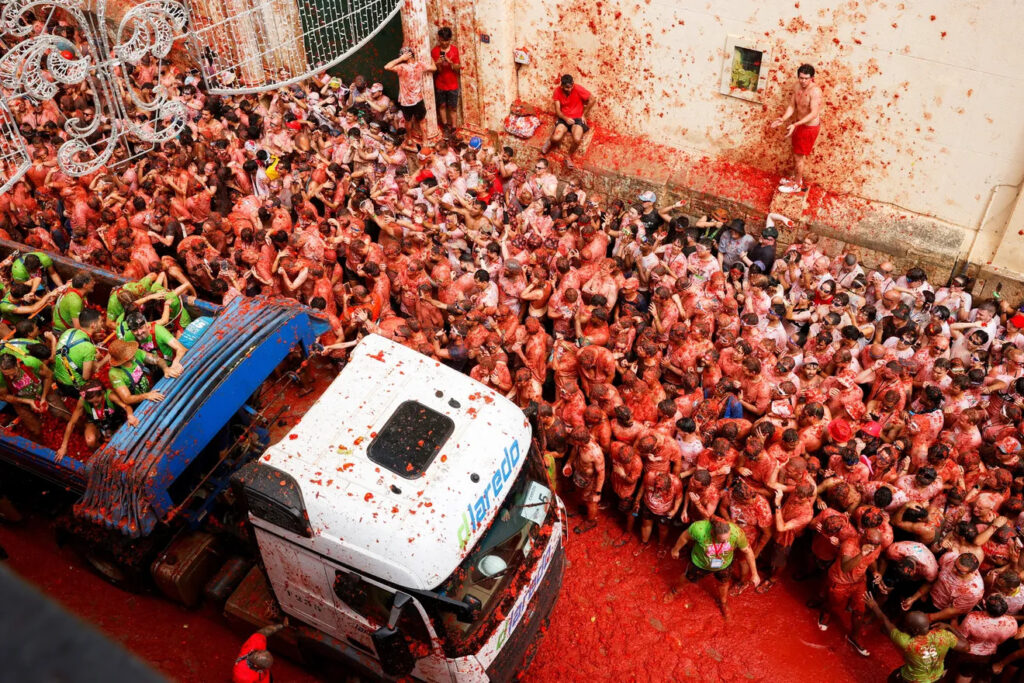
Want to throw food at friends and complete strangers? La Tomatina is for you.
On the last Wednesday in August the quiet town of Buñol, just outside Valencia, hosts the biggest food fight in the world: the tomato fight.
Over 20,000 people cram into the streets of the small town as trucks piled high with hundreds of tons of soft, juicy, overripe tomatoes make their way into the throng.
And then the battle begins. It only lasts an hour and it’s a fight with no sides, no rules, and no winners. You just grab handfuls of tomatoes, give them a smack to make sure they are good and soft, and then hurl them at anyone – or anything – that moves. Within minutes the streets and the crowds are painted red, tomato pulp is splattered across walls, windows and pavements, and you’re covered, head to toe, in sticky juice and flesh.
It may be a ‘battle’ but it’s the most good-natured fight you’re likely to find yourself in. Everyone is smiling and laughing, united in gleeful mayhem, even as they wipe pips and juice from their eyes, and try not to slip in the rivers of tomato that flow around their feet.
Is there any point to this fight? None at all. Is it messy? Beyond belief. Hilarious? Without a doubt.
A word of warning to the uninitiated: tomato juice in the eye stings and tomato pips in your ear can be very hard to retrieve, so those in the know go prepared with swimming goggles and ear plugs. And don’t wear anything you’re attached to as by the end of the hour your clothes will be fit for only one place: the garbage.
La Tomatina has become so popular that numbers have had to be limited, so if you want to join in, be sure to book well in advance.
A Spanish Festival to Remember: Drowning in Fine Wine (La Batalla del Vino)
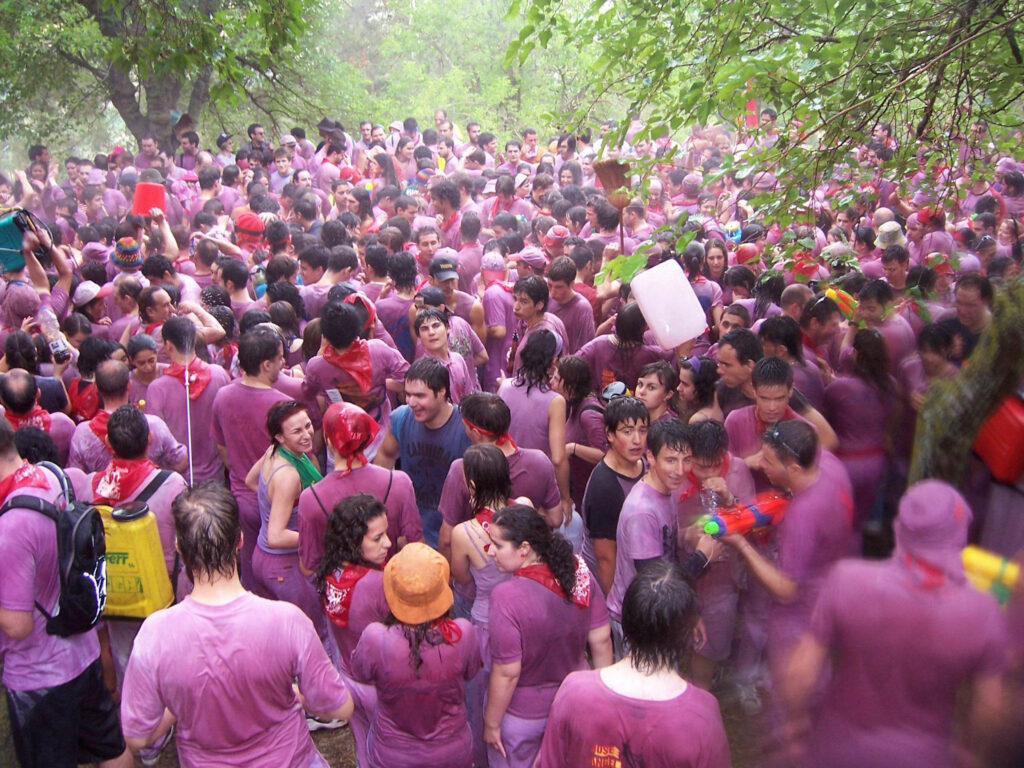
On June 29, in the winemaking town of Haro, locals and visitors head into the hills to douse each other in vast amounts of perfectly good red wine.
Why? No one really knows, and nobody really cares, how this peculiar event came to be – they just know it’s good, wholesome(ish) fun.
The only rule is that you must wear white.
Then you choose your weapon: anything that holds liquid (other than glass bottles) is fair game. Think balloons, jerry cans and water pistols. It really doesn’t matter as no one is taking any of it very seriously.
The aim of the game is to completely soak each other, tip to toe, so that when you emerge your white attire is totally purple.
Like so many festivities, it’s gloriously messy, completely without rhyme or reason, and your clothes will be ruined. But this is all about the camaraderie, the laughter – and wasting good wine in the name of fun.
In a world where entertainment has often become sanitised and safe, Spain’s festivities offer something raw, real, and truly unforgettable. Yes, they’re chaotic. Yes, they’re dangerous. And no, there’s no clear reason why they celebrate this way – but that is the point. Because what makes you feel more alive than abandoning all sense of caution and diving headfirst into pure, unadulterated revelry? Viva España!
What’s San Fermín in Pamplona?
A nine-day July fiesta with a daily morning bull run through narrow streets plus nonstop concerts, food, and fireworks.
What happens at Menorca’s Sant Joan Jaleo?
Black stallions and riders in traditional dress rear and step through a tightly packed crowd to brass-band music—thrilling, chaotic, and intimate.
Why is Valencia’s Las Fallas famous?
March brings deafening midday mascletà firecracker barrages and the fiery burning of towering papier-mâché sculptures on the final night.
What’s La Batalla del Vino in Haro?
On June 29, everyone in white soaks each other in red wine in the hills until outfits turn purple—pure, tipsy camaraderie.

